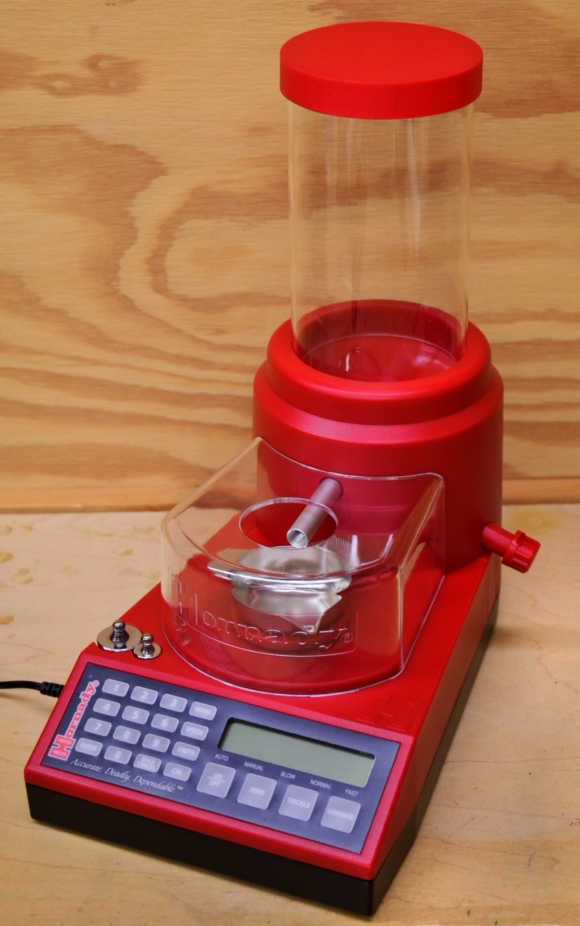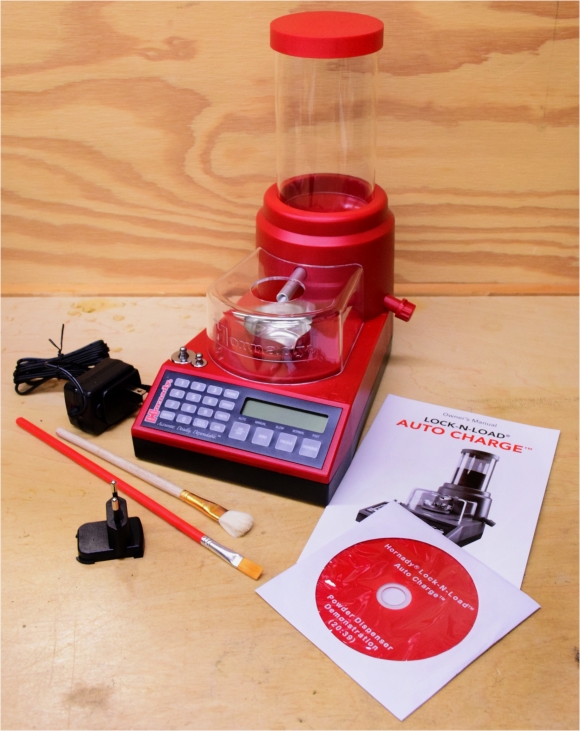
It is always good to check out new equipment as the effort can sometimes lead to improving handload production, quality and/or quantity. Methods of weighing and dispensing charges are central to any reloading set up and their applicability varies with reloading objectives. Reloading in support of a 1,000 round a week pistol shooting effort requires a quite different set up than a 40 round a week hunting rifle proficiency effort. The evidence of those conclusions can be found in the shop loft as equipment left in the wake of these types of changing demand.
Writing about firearms and carrying on a personal interest in firearms leads to a lot of variety in cartridge type and in demand. One project involves a .17 caliber 20 grain capacity cartridge, the next a .50 caliber with 165 grain capacity. One project is based on using Unique, the next on using Reloder 26. Handload development runs are short, subsequent T&E loads rarely exceed 50 rounds and control lots are batch processed. Personal consumption for hunting and firearm proficiency rarely exceed a couple of hundred rounds at any point in time. Being precise, checking and rechecking assembly and results are essentials. All of this makes me a candidate for a good scale / auto dispensing piece of equipment. The equipment keeps evolving, so I keep checking in.
The Hornady Lock-N-Load Auto Charge is supplied with 9volt power supply and 110V plug, 220V convertor plug, cleaning brushes, instructional video DVD, and instruction manual. This is in addition to standard components: pan, draft cover and calibration weights. It is a one piece design, more compact and lighter than my RCBS ChargeMaster 1500 and approximately $125 less costly with a discount retail $235 price tag.
Performance is sometimes hard to qualify as manufacturers tend to rate in grains fed per second, which is relatively meaningless as there is often much more that contributes to cycle time. Some reviewers hack equipment and measure net cycle time while omitting dwell time and time lost to over/under charges as they get motors to spin faster longer, while ignoring ease of adaptability to various powder types and charges i.e. “Hold down the trickle button while holding down the enter button while holding down the the power button… while putting your left foot out and shaking it all about and keep trying until it works”.
Capacity and metered charge range
Every once in a while there is a conflict between what appears on a product web site, the products instruction manual and the product. The Hornady site indicates 1000 grain hopper capacity and 300 grain charge capacity, the instruction manual does not indicate hopper capacity, it does indicate a 1000 grain scale capacity and a 300 grain charge capacity. In examination, the instruction manual appears to be correct and the hopper will easily hold a pound, 7000 grains, of powder. The lower charge limit is not stated, but I was able to meter 3.0 grains of Bullseye which, at that point, rendered any greater resolution academic.
Environmental influences
Like all consumer grade digital scales, the operating temperature range is well beyond what would be experienced in a reloading bench. What is greatest importance is a warm up period to stabilize circuits, fifteen to twenty minutes, a constant temperature to hold zero and a draft free area as no sensitive scales will produce consistent readings with a fan or heater blowing on its pan. Low hanging florescent lights, ringing cell phones and other electromagnet interference producing devices can disrupt operation the Auto Charge’s operation. Again, not unique to the Hornady unit.
Packaging and controls
The Hornady Auto Charge scale and dispenser function are integrated into one covered assembly with sealed touch keypad, unlike others that are made by plugging a scale into a dispenser. That eliminates connectors what work loose in use. Powder is drained through a drain plug on the side of the unit. The clear plastic hopper is removable and intended only as a temporary working, not storage hopper. The draft cover is effective, but car must be taken, when placing or removing, to not bump the base or metering tube and inadvertently cause powder to drop into the pan. Two weights, 50g and 10g, check weights are used to calibrate the scale, something that should be done at the start of each use.

The sealed membrane keypad is relatively simple in layout as it is used for metering or controlling metering functions and not data entry. There is no facility for saving favorite handloads, which is not tragic for me as I have never use an auto powder dispenser for that purpose, even when it had that capability as those little keys are not really made for extensive alphanumeric input. A number of the control keys serve multiple functions, but all control functions are well documented and easy to execute. The display is bright, back lit and characters well formed.
Control feature highlights…
Unique charge quantities can be metered by simply entering the charge amount in grains and pressing “Dispense”. A charge can be made repetitive by entering the charge, pressing “Enter” to create a “Target” charge and then every time “Dispense” is depressed that same charge will be dispensed. The Hornady Auto Charge can be set to auto dispense so that every time the scale senses an empty pan it will automatically meter the “Target” charge.
Metering speed in controlled in several ways, all are easily adjustable, but still require trial and error to optimize. There are two actions at work, dispense and trickle. Dispense is fast with coarse increments of powder dropped into the pan. The second action is trickle with is the fine metering of powder that takes over as the selected charge amount approaches. At the “Slow” setting, trickle takes over for the last 1 1/2 grains. At the “Normal” setting, trickle manages the last whole grain. At the “Fast” setting, tickle is left for the last 1/2 grain. Why?
Set to “High” speed, high density powder momentum can easily overshoot the cycle of scale feedback to the dispenser and yield an “Overload” indication; the metered charge exceeds the target weight by 0.2 grains. At the “Slow” setting, low density powder metering could provide time for a substantial nap. The learning curve for what powder works best is sharp and brief so, not a big deal. In a hurry and don’t want the time to play maestro of the dispenser? “Normal” speed works well for most everything, the rest is fine tuning. Trickle performance can also be independently adjusted in three ways: speed, duration and trickle motor twitch.
How fast is the Hornady Lock-N-Load Auto Charge? That depends…
| Seconds Per Dispense Cycle | |||||
| HS-6 | 6 Grains | Win 748 | 50 Grains | IMR 3031 | 38 Grains |
| Fast | Normal | Fast | Normal | Fast | Normal |
| 11.7 | 19.6 | 18.9 | 23.8 | 15.9 | 21.4 |
| 8.0 | 10.0 | 23.6 | 19.4 | 13.8 | 13.8 |
| 7.7 | 13.2 | 17.7 | 18.2 | 13.2 | 15.9 |
| 8.8 | 15.4 | 18.1 | 26.2 | 14.3 | 26.8 |
| 8.9 | 6.8 | 20.4 | 18.2 | 13.3 | 27.1 |
| 13.3 | 11.2 | 17.8 | 17.1 | 13.4 | 29.4 |
| 8.0 | 25.2 | 17.5 | 18.0 | 12.6 | 20.2 |
| 10.4 | 10.6 | 17.5 | 19.3 | 14.9 | 23.1 |
| 6.3 | 13.1 | 18.4 | 18.5 | 13.7 | 24.2 |
| 9.9 | 9.7 | 20.1 | 19.2 | 14.2 | 16.8 |
| Average Dispense Times |
|||||
| 9.3 | 13.4 | 19.0 | 19.8 | 13.9 | 21.8 |
| Number Of Overs | |||||
| 1 | 0 | 2 | 0 | 2 | 2 |
The table is not an illustration of fastest speeds possible, but rather an indication of the degree of change that comes with altering the dispense – trickle relationships. Times were taken on auto dispense from the time the scale pan zeroed until the complete cycle beep sounded. Within the numbers, the coarse dispense times are very constant, it is the trickle portion that is time consuming, sometimes taking a full 10 seconds to meter the last 0.2 grain of rifle ball and stick powders. A little time spent experimenting with trickle parameters could yield big dividends.
When the metered amount exceeds the target weight by 0.2 grain, the scale cuts off an “Over” is displayed. This never exceeded 0.2 grain and was remedied by dumping the errant charge back into the hopper and then returning the pan to the platen to be auto filled. I did not spend a good deal of time with Winchester 748, consequently, the degree between normal and optimized was small. This could have benefited from changes to trickle speed. None of this is unique to the Hornady Auto Charge compared to competitors and the Hornady Auto Charge offers more tools to correct over/under dispensing.
Overall
There are currently four suppliers of powder scales with dispensers: RCBS with the ChargeMaster 1500 $369 and ChargeMaster Lite $225, Franklin Arsenal Intelli-Dropper $215, Hornady’s Lock-N-Load Auto Charge $235, and Lyman’s Gen 5 $300 & 6 $235 Touch Screen. Prices are popular discount retailers. Within this population based on function and features, I do believe the Hornady unit is value priced.
How does it compare to my RCBS ChargeMaster 1500? Other than the $125 lower price tag and absence of a favorite load database, the Hornady unit is as reliable, faster, more easily tuned and it takes up less space. Any warts? Under low mounted florescent lights, my cell phone ringing froze the display and I needed to… power cycle the unit to restart. That problem is solved by following the simple cautions in the instruction manual. Nice equipment.


Email Notification